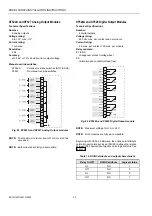
EXCEL 500/600 INSTALLATION INSTRUCTIONS
Automatic Baudrate Synchronization
The default communication speed between the
XC5010C/XCL5010 CPU and the local modem/ISDN terminal
adapter is 9600 baud.
The communication speed between the XC5010C/XCL5010
CPU and XBS modems/ISDN terminal adapters is auto
matically synchronized by the two devices to the highest
speed that both of the devices are capable of. This feature is
called autobauding and is a feature that all state-of-the-art
modems/ISDN terminal adapters provide when left in their
factory default settings.
The communication speed between the XBS and its
modem/ISDN terminal adapter is part of the modem set-up at
the XBS.
Auto / Manual Answer Detection
The XC5010C/XCL5010 CPU will automatically detect
whether the modem/ISDN terminal adapter is initialized in
auto-answer or manu-answer mode, and it will set the modem
to manual answer mode (S0 = 0).
Resetting the Modem
For those cases where it is not clear if the modem to be used
is in its factory setting, the modem can be reset to its factory
setting by using the RESET MODEM command in the Start
up sequence or through the HW Config. part of the System
Info. sequence on the MMI. This will allow a quick and easy
modem reset without the need to run the modem set-up
software or the Windows™ terminal program.
The RESET MODEM command causes the following
commands to be sent to the modem:
1. ATZ
executes hardware reset on modem
2. AT&FX3&W
resets modem to factory configuration settings,
configures the modem not to wait for the public phone
system dial tone, and writes this to nonvolatile memory.
Set-up for Special Modem Behavior
If special modem/ISDN terminal adapter behavior is required,
the communication device should be set up according to the
instructions provided with it. This typically involves running a
setup program on a computer with the device connected to
the computer serial port or using the Windows™ terminal
program.
Set-up for In-house Telephone Systems
A common case of special modem behavior is when the
modem is connected to an in-house telephone network
requiring a prefix to be dialed before the destination number
to provide access to the public telephone network. There are
two important aspects of the special initialization of the
modem to consider:
1.
Do not wait for the public network dial tone. Typically
the init command ATX3 will trigger the modem to dial
without waiting for a public network dial tone. Save this
modem set-up in the modem EEPROM with the
command AT&W. Check the modem handbook to verify
the correct commands. Note that these commands are
executed automatically with the RESET MODEM
command.
2.
Add the prefix required for access to the public
telephone network to the destination telephone number.
Depending on the in-house telephone system, a certain
prefix may have to be added to the destination number
in the XBS system configuration/site definition screen
prior to sending the set-up to the remote Excel 500
controller.
Set-up for Limited Communication Speed
The communication speed of the modem can be fixed to a
lower rate in case of data transmission errors due to tele
phone line limitations. See the XI581/582 Buswide Operator
Interface User Guide (EN2B-126GE51) for the procedure for
fixing the baud rate.
Troubleshooting
In case of any problems the handbook of the modem or ISDN
terminal adapter must be consulted.
A “Frequently Asked Questions and Troubleshooting”
document is available via the Honeywell Technical Assistance
Center (TAC) or, for Honeywell employees, on the HIVE
under:
Technical Assistance Center/Controllers/Excel 80 and 100
and 500 and 600/ technical literature/modemfaq.doc
or on the Docu Server under:
http://web.ge51.honeywell.de/dep/mc/TAC_Tips/Modem
FAQ.doc
TCP/IP Dial-Up via TCP/IP Modem XM500
The Honeywell TCP/IP modem XM500 allows use of a
TCP/IP network (e.g. Ethernet LAN/WAN networks) to
achieve a dial-up connection between an XBS building
supervisor and an Excel 500 controller. The set-up is identical
to that of a telephone modem connection with the exception
of the additional need for definition of the Ethernet address.
Details can be obtained from the XM500 Product Data
Documentation on the Honeywell Intranet under:
GSM Communication (Europe, only)
For communication via the Global System for Mobile
communications (GSM), a Siemens M20 Terminal (cellular
engine) is required and must be connected directly to the
serial port of the Excel 500 controller. The M20T translates
the Excel CPU data received in transparent mode into the
GSM standard. The M20T behaves like a Hayes-compatible
EN1R-1047GE51 RR0902
44





































